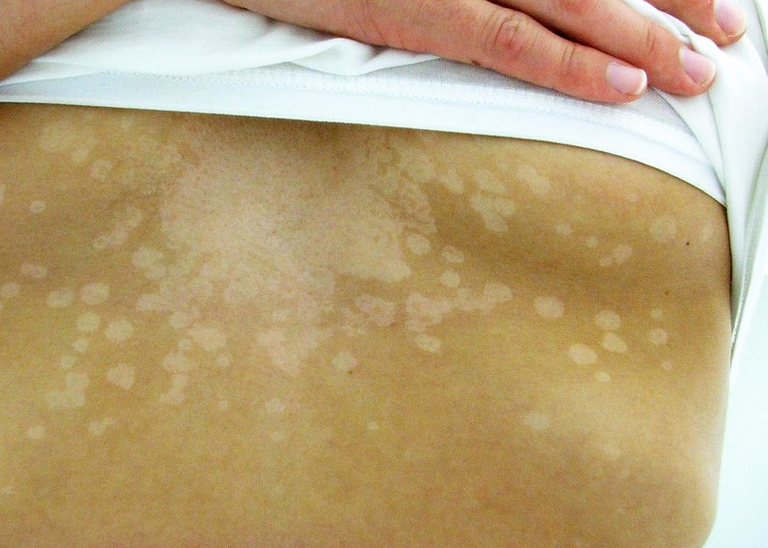Pityriasis Versicolor: A common skin lesion in the Tropics

By Sarahrosenau on Flickr.com - Flickr.com, CC BY-SA 2.0, https://commons.wikimedia.org/w/index.php?curid=18575524
What is Pityriasis Versicolor?
Pityriasis Versicolor (PV) is also known as Tinea versicolor and
commonly mistaken for eczema or dermatitis. It is a superficial fungal infection localized to just the top layer of the skin.
It usually presents as discolouration on the skin particularly on the chest, back, fore arm and face. The culprit organism responsible for this lesion is called Malassezia which is a fungi that is normally present in the skin, but due to some host factors such as malnutrition or long use of steroids this fungi accumulates on the skin, produces azelaic acid and cause the lesion to appear.
Aetiology and Symptoms
PV is caused by an overgrowth of a fungi called Malessezia. It commonly affects young adults and teenagers.
Although it's an jnfection that is caused by a fungi called Malessezia, there are predisposing factors to developing this condition ànd they include: hot and humid environment such as in Nigeria, immunosuppressive conditions such as in those with HIV or diabetes, malnutrition, long use of steroids (such as those found in bleaching cream and triple action cream) and pregnancy. Studies have also shown that usage of bath oils and skin lubricants can predispose one to the infection (because the organism is lipophilic).
As noted earlier, this condition usually presents with hypopigmented or hyperpigmented patches on the skin, particularly in areas with high sebum production as the organism thrives in oily areas such as the face, chest, back, fore-arms and occasionally the scalp. This is rarely associated with itching. It causes more of a cosmetic nuisance without any symptom
It is a very common skin lesion in tropical region and is often mistaken as dermatitis due to the similar presentation. It has a tendency for recurrence because of its genetic predisposition and the humidity of the tropics. It is non-contagious as the organism is a normal inhaitant on the human body.

Diagnosis
Pityriasis versicolor is usually diagnosed by the classic hypopigmented or hyperpigmented lesions which often starts as minute oval to round patches and then gradually coalesce to form large patches with mild scale.
It can occasionally be difficult to distinguish PV from other skin lesions, that's why it's commonly referred to as eczema.
Although the diagnosis is made clinically, it can be confirmed by scraping the skin and sending it for microscopic examination and culture
Patient Education
It is important to educate the patient about the condition especially that it can recur, which does not mean the treatment failed.
It is also necessary to emphasize that even after treatment, the colour change that occurs with the infection might require weeks or months to return back to the original skin colour, especially when the colour change is lighter than the surrounding skin (hypopigmentation)
Treatment
After diagnosis, treatment of Pityriasis versicolor is with the use of antifungal shampoos and creams. Also antifungal tablets can be added. It is important to not self medicate and visit a dermatologist before taking any medication.
For patients with frequent reoccurrences, maintenance therapy should be instituted. It is advised that once or twice weekly washing of the affected areas with a selenium sulphide or ketoconazole shampoo is sufficient in keeping the condition at bay.

source
Prevention
Dermatologists are not sure as to why some individuals are more prone to PV more than others. However, those with previous history or family history of PV are usually advised to use soap containing zinc pyrithione, ketoconazole or selenium sulphide as these soaps help prevent the overgrowth of the fungi
Other precautions include:
Application of sunscreen or wearing of clothes thar reduce sun exposure to the body.
Wearing loose-fitting, light coloured clothes to reduce humidity and sweating.
Avoid excessive sweating and exposure to heat.
Wash clothes with warm water to kill the fungus and sun dry clothes thoroughly before wearing.
Conclusion
It is important to note that PV is common infection in the tropics. Self medication and the use of home made remedies such as medicated soaps, hydraulic oil and brake fluid can cause complications and should not be used.
It is safer to wear light coloured clothes and fabrics that reduce humidity rather than dark coloured and thick fabrics
References
- Medscape- Pityriasis Versicolor
- Wikipedia- Tinea versicolor: symptoms, causes and treatment
- Davidson Principle and Practice of Medicine- skin lesions: Tinea Versicolor
Yeah, I have seen this condition in some instances and it gives some concerns to the patients especially cosmesis. Nobody wants to be seen with rashes on the body. However with the right treatment, the issues can be addressed.
Thanks for sharing.
Thank you 🤗
I hate fungi infections lol
!1UP
You have received a 1UP from @gwajnberg!
@stem-curator, @vyb-curator, @pob-curator, @neoxag-curator, @pal-curator
And they will bring !PIZZA 🍕.
Learn more about our delegation service to earn daily rewards. Join the Cartel on Discord.
Most times I tend to confuse the difference between eczema and dermatitis
Yeah most people get confused. But eczema is a form of dermatitis. Just that eczema is dry and scaly